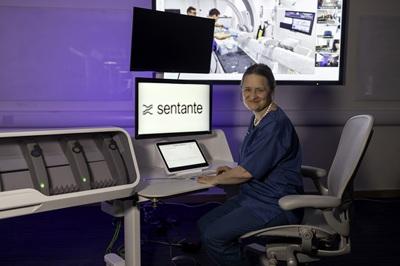
The University of Dundee has bolstered its position as a global leader in stroke treatment and training by taking part in the world’s first robotic transatlantic thrombectomy.
The event came hours after Dundee’s Professor Iris Grunwald, Director of the Image Guided Therapy Research Facility (IGTRF), performed the first-ever remote thrombectomy on a human cadaver.
Using a cutting-edge robot developed by Lithuanian MedTech company Sentante, Professor Grunwald proved that a blood clot could be removed from the brain without a specialist being physically present when she performed the procedure from a remote site within the School of Medicine at Ninewells Hospital.
That was followed by the groundbreaking moment when Ricardo Hanel MD, PhD – in conjunction with Professor Grunwald – used Sentante’s device to perform the first transatlantic thrombectomy on a human cadaveric model located at the IGTRF from Baptist Medical Center in Jacksonville, Florida.
The Sentante platform uses standard guidewires and catheters connected to a device equipped with a high-resolution sensory system that captures the specialist's hand movements. These manipulations are replicated in real time by a robot at the patient's bedside.
Unlike joystick-controlled surgical robots, Sentante delivers authentic force feedback directly to the surgeon's fingertips – recreating the tactile experience of manual surgery. The procedure only necessitates a medical professional trained to gain arterial access before a specialist such as Professor Grunwald or Dr Hanel performs the thrombectomy remotely.
Professor Grunwald said, “As a neurointerventionist, it is remarkable to feel the same fine control and resistance through a robotic interface as during a live procedure. Sentante’s technology truly bridges the gap between operator and patient, no matter the distance. Sentante’s robotic platform redefines what is possible in endovascular treatment today. It is precision, safety and access to treatment - all in one innovation.”
Each year, there are about 15 million strokes worldwide. For the UK, the aggregate societal cost is estimated at £26 billion per year, including £8.6 billion for NHS and social care.
Thrombectomy is considered the most effective way to treat patients with stroke caused by a large, blocked brain vessel but, in many parts of the world, less than 1% of patients receive this life- and brain-saving treatment. In 2024 only 212 patients received a Thrombectomy across Scotland. This represents 2.2% of patients who had an ischemic stroke.
One of the major constraints to expanding thrombectomy services is the number of interventional neuroradiologists required to carry out the work.
“By the time patients reach a specialist centre, there’s often no brain left to save. Every six minutes delay in receiving treatment equates to a 1% lesser chance of a good outcome,” continued Professor Grunwald. “For example, here in Dundee we're covering the north of Scotland – so a patient coming from Inverness or one of the islands would have a long distance to travel. The answer lies in expanding expertise locally through cross-specialty training, or by using robotic technology, such as Sentante, that lets experts operate remotely.”
Dr Hanel added, “Tele neurointervention will allow us to decrease the gap and further our reach to provide one of the most impactful procedures in humankind – the thrombectomy – to more people. To operate from the US to Scotland with a 120 millisecond (blink of an eye) lag is truly remarkable.”
The IGTRF is the official global training centre for the World Federation for Interventional Stroke Treatment, training doctors and teams from across the world. The facility offers a unique medical imaging environment that works in close collaboration with Dundee’s Centre for Anatomy and Human Identification (CAHID) to provide interventional training, medical device testing and research opportunities.
One of the University’s key strengths is the development of a perfused whole body human stroke model, which most closely approximates to ‘life-like’ patient simulation.
Edvardas Satkauskas, co-founder and CEO of Sentante, said, “The human cadaveric models at Dundee are fantastic. This is the reason we have worked with them – this is probably the only site in the world that can do this type of research.
“For an ischaemic stroke, the difference between walking out of hospital and a lifetime of disability can be just two to three hours. Today, patients are often transported long distances to reach one of a limited number of thrombectomy centres. With Sentante, the specialist comes to the patient over a secure network and performs the entire procedure remotely – with the same tactile feel and control they have at the bedside.”
Sentante’s robotic platform is advancing through regulatory pathways for peripheral vascular interventions, with the FDA granting Breakthrough Device Designation for its stroke system. The Dundee collaboration marks the next milestone, showing how robotics can remove distance as a barrier to life-saving care.